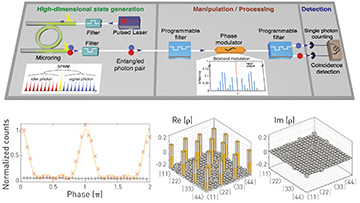 Top: An optically excited integrated nonlinear micro-cavity creates high-dimensional entangled photon pairs, processed using a concatenation of spectral programmable filters and an electro-optic modulator. Bottom: Quantum interference and tomographic reconstruction of the density matrix for a 4-D qudit state.
Top: An optically excited integrated nonlinear micro-cavity creates high-dimensional entangled photon pairs, processed using a concatenation of spectral programmable filters and an electro-optic modulator. Bottom: Quantum interference and tomographic reconstruction of the density matrix for a 4-D qudit state.
Considerable efforts have recently focused on advancing quantum information processing by increasing the number of qubits (the simplest unit of quantum information) in nonclassical systems such as ultracold atoms and superconducting circuits. A complementary approach to scale up information content is to move from two-level (qubit) to multilevel (quDit) systems.
Realizing solid-state quDits would require a massive increase in both costs and experimental complexity. In recent years, researchers have demonstrated photonic quDits using, for example, orbital angular momentum1 as well as the temporal or spatial degree of freedom.2,3 Even these schemes, however, require complex implementations and are not directly compatible with today’s scalable and modular optical systems based on fiber and integrated-photonics components.4 Thus, to date, on-chip entangled quantum sources have been limited to qubits.
In recent work, we demonstrated—making use of the frequency domain—on-chip generation of entangled quDit states and their coherent control.5 The photons were created in a coherent superposition of multiple frequency modes using spontaneous four-wave mixing within an integrated microcavity, forming a frequency-bin entangled state. We confirmed the realization of a quantum system with at least 100 dimensions, formed by two entangled quDits with D = 10.
Using off-the-shelf telecommunications components, we introduced a coherent control platform to manipulate frequency-bin entangled states, capable of performing deterministic high-dimensional gate operations. We validated this platform by showing violations of high-dimensional Bell inequalities and performing quantum state tomography.
The quantum states were generated and manipulated within a single spatial mode and were transmitted over long propagation distances using standard optical fibers, which underscores their usability for high-dimensional quantum key distribution applications. The approach can also easily support the generation and control of even higher-dimensional states, by considering a larger number of frequency modes. Our results suggest that microcavity-based high-dimensional frequency-bin entangled states and their spectral-domain manipulation can constitute a powerful yet practical platform for reaching the processing capabilities required for meaningful quantum information science.
Researchers
M. Kues, C. Reimer, P. Roztocki, L. Romero Cortés, S. Sciara, J. Azaña, Y. Zhang and R. Morandotti, INRS-EMT, Varennes, Quebec, Canada
B. Wetzel, University of Sussex, Brighton, U.K.
A. Cino, Universita degli Studi di Palermo, Palermo, Italy
S.T. Chu, City University of Hong Kong, Hong Kong
B. Little, Chinese Academy of Sciences, Xi’an, China
D. Moss, Swinburne University of Technology, Hawthorn, Victoria, Australia
L. Caspani, University of Strathclyde, Glasgow, U.K.
References
1. A. Mair et al. Nature 412, 313 (2001).
2. C. Schaeff et al. Opt. Express 20, 16145 (2012).
3. R. Thew et al. Quantum Inf. Comput. 4, 93 (2004).
4. S. Tanzilli et al. Laser Photon. Rev. 6, 115 (2012).
5. M. Kues et al. Nature 546, 622 (2017).
